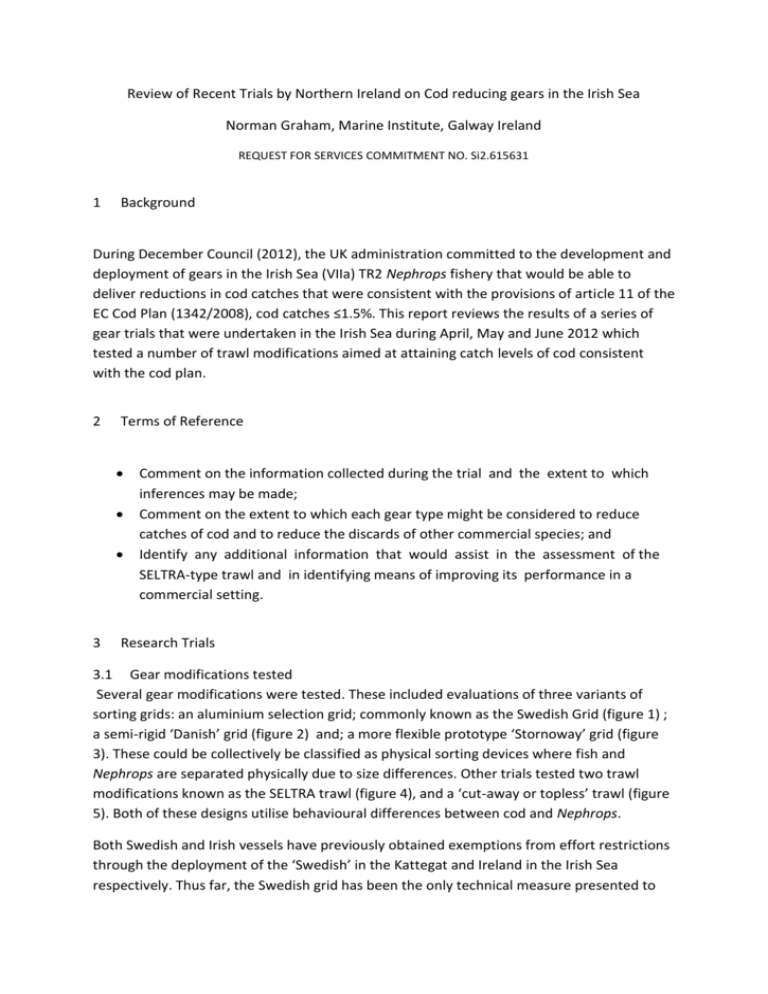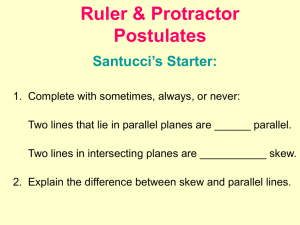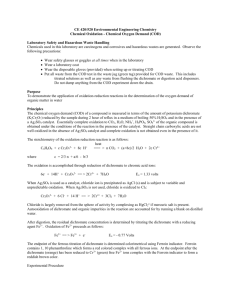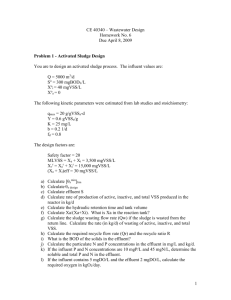Review of Recent Trials by Northern Ireland on Cod
advertisement

Review of Recent Trials by Northern Ireland on Cod reducing gears in the Irish Sea Norman Graham, Marine Institute, Galway Ireland REQUEST FOR SERVICES COMMITMENT NO. Si2.615631 1 Background During December Council (2012), the UK administration committed to the development and deployment of gears in the Irish Sea (VIIa) TR2 Nephrops fishery that would be able to deliver reductions in cod catches that were consistent with the provisions of article 11 of the EC Cod Plan (1342/2008), cod catches ≤1.5%. This report reviews the results of a series of gear trials that were undertaken in the Irish Sea during April, May and June 2012 which tested a number of trawl modifications aimed at attaining catch levels of cod consistent with the cod plan. 2 Terms of Reference 3 Comment on the information collected during the trial and the extent to which inferences may be made; Comment on the extent to which each gear type might be considered to reduce catches of cod and to reduce the discards of other commercial species; and Identify any additional information that would assist in the assessment of the SELTRA-type trawl and in identifying means of improving its performance in a commercial setting. Research Trials 3.1 Gear modifications tested Several gear modifications were tested. These included evaluations of three variants of sorting grids: an aluminium selection grid; commonly known as the Swedish Grid (figure 1) ; a semi-rigid ‘Danish’ grid (figure 2) and; a more flexible prototype ‘Stornoway’ grid (figure 3). These could be collectively be classified as physical sorting devices where fish and Nephrops are separated physically due to size differences. Other trials tested two trawl modifications known as the SELTRA trawl (figure 4), and a ‘cut-away or topless’ trawl (figure 5). Both of these designs utilise behavioural differences between cod and Nephrops. Both Swedish and Irish vessels have previously obtained exemptions from effort restrictions through the deployment of the ‘Swedish’ in the Kattegat and Ireland in the Irish Sea respectively. Thus far, the Swedish grid has been the only technical measure presented to STECF with scientific evaluation from gear trials (Valentinsson and Ulmestrad, 2008) and follow up observer data that has demonstrated cod catches ≤1.5%. (STECF PLEN 10-01, STECF 09-03 OWP) Figure 1. Swedish grid (left) and mounting position in the trawl (right) Figure 2. Danish plastic grid (left) and mounting position in the trawl (right) Figure 3. Stornoway plastic grid (left) and mounting position in the trawl (right) The SELTRA trawl, a four panel section with a large (300mm) square mesh upper panel, has been tested in the North Sea (Madsen et al, 2010) and was shown during experimental trails to reduce cod catches in excess of 85%. This gear is used as part of the Danish cod reduction plan in the Kattegat to increase fishing effort allowances under article 13 of the Cod Plan (STECF PLEN 11-01). Thus far, there has have been no submissions to the EC to evaluate the SELTRA trawl as the basis of exemption under article 11(2). Figure 4. Positioning of the SELTRA trawl (left) and large mesh upper panel (right) The cut-away or topless trawl (figure 5) is a modification that has been extensively tested in several UK and Irish Nephrops fisheries (e.g. Revill et al, 2006) to reduce fish by-catch. Revill et al (2006) while noting substantive reductions in the by-catch of whiting, the authors were unable to detect any significant reductions in cod catches with this modification but the number of cod caught during the trials was very low although catches of cod below MLS were lower with the modified gear, but this was not significant. Cod catches above the MLS were almost identical. Figure 5. Cut-away trawl (right) compared to the standard trawl (right) 3.2 Experimental Design All gear variants were tested on twin rig and single rig vessels. Both single and twin rig gears are used by the Northern Irish fleet and trialling on both allowed for an evaluation of the technical suitability from a practical handling perspective. For the twin rig vessels, one trawl was used as a control net, the other fitted with the modified (experimental gear). Two comparative single rig vessels, in terms of vessel length, power and trawl size, were used to undertake parallel hauls, with one vessel using a standard trawl, the other fitted with the experimental design. While the original intention was to have two identical new trawl build for both the single and twin rig experiments, time constraints only permitted the construction of new experimental trawls, which were contrasted against the vessels existing standard (control net). This may have lead to some bias in the results, but how significant this may be is unknown. In general, the parallel haul technique allows for evaluation to be made between gear modifications on vessels that are only capable of towing single rig trawls. The major disadvantage of this approach (Anon, 1996) is that catch rates can be quite variable between vessels simply due to the differences in spatial coverage that may affect the demographic distribution of fish entering the gear and due to vessel or skipper effects that can also cause differences in catching efficiency. As such, the parallel haul technique, while useful from a practical and technical evaluation e.g. handling issues etc. The inherent variation in catches makes detecting significant differences in catches that can be solely attributed to the gear modifications difficult, and requires substantive amounts of data e.g. replicate hauls. The twin trawl technique can be considered more robust in that the vessel and skipper effects are eliminated and while there is inherent variation in the catch demographics, this is less of an issue as the two nets are towed in closer proximity. 4 Results The report from Montgomerie and Briggs (2012) presents data on total catch, Nephrops catch and cod catch by weight and the percentage contribution cod makes to the overall catch. No attempt has been made to test whether the differences in catch between the control and test gears are statistically significant; this has been done for the purpose of this review. Relative length frequency distributions for other species are presented in the report which is useful in determining whether each modification has some length dependent effect and catch numbers at length for each trial have also been provided in separate tables. Further analysis of this data would have been helpful in determining the impacts on other species which is noted as being of concern in the report. In particular plots of the proportion retained at length for each species and a tests for statistical significance in catch weights between the test and control gears. 4.1 Swedish Grid The report from the trials (Montgomerie and Briggs, 2012) highlights a number of problems experienced with all of the grid designs. The trials with the Swedish grid on the single rig (parallel haul) highlight blocking of the grids with marine debris during all experimental hauls and during 3 of the 12 hauls from the twin rig experiments. This is attributed to the ‘unique hydrographic conditions’ in the Irish sea, where a central gyre is considered to be responsible for the concentration of marine debris. Secondly, it is noted that handling of the grids presented safety concerns due to onboard handling and risks associated with fouling the propeller when lifting the cod-end onboard. Additionally, it is concluded that if the vessels were to operate the grid commercially it would necessitate that the entire gear handling system and deck layout would need to be redesigned. This has not been the experience in Sweden or Ireland as the grids are only stored on the net drum at the end of each trip and are not required to pass through a power block as they are inserted relatively close to the cod-end. Cod catches in both the control and standard net in the twin rig trials were very low (19.7 kg and 0.17 kg in the control and experimental nets respectively over 12 hauls) for the hauls without blockage problems, the cod catch was significantly lower (P<0.0001). With cod composition, (relative to the bulk catch) being 0.9% and 0.01% for the control and experimental net respectively. Nephrops catches were reduced by 15% but this was not found to be statistically significant (p=0.49). Catch rates of other species were very low even in the standard gear although there are indications that the test gear actually retained more small whiting than the control, this is due to the reduced bulk catch in the cod-end reducing the mesh opening and limiting escapement of small fish. This phenomenon has been noted elsewhere e.g. Catchpole et al, 2006. There was insufficient data to describe the impact on catches of other commercial species. As this device is already exempted in two other fleets, one operating the same area, the device does offer high potential to attain exemption. However, the tone of the report suggests that this is not considered as viable design for this fleet due to blockage and loss of commercial fin-fish catch. Given that all hauls undertaken during the single rig (parallel haul) experiments were foul, it is not possible to undertake any catch analysis for this experiment. 4.2 Plastic Grid (Stornoway design) This design was considered appropriate from a handling perspective, but suffered from similar blockage problems as the Swedish Grid, with 3 out of the 12 hauls being considered as foul due to blockage of debris during the twin rig experiment and 2 out of 12 hauls from the parallel haul experiment. From the twin rig, When fouled hauls were excluded from the analysis the losses were found to not to be statistically significant (p=0.06), but only marginally. Cod catches were extremely low with only 0.67 kg and 1.2 kg being caught in the control and experimental nest respectively. No robust analysis is therefore possible. From the parallel haul trials, Nephrops losses were much higher and were statistically significant (p=0.002). Cod catches were much lower in the experiential net and the reductions found to be highly significant (p<0.001). Handling issues were less of an issue with this design. While the device has less handling issues, it is clear from the report that this is not considered as a viable design without further research work and at this stage cannot be considered as a candidate for attaining cod catches consistent with article 11(2) in the short term. 4.3 Plastic Grid (Danish design) This variant was only tested using the parallel haul (single rig) technique. Cod catches were again very low with only 22.59 kg and 7.35kg in the control and experimental net respectively, despite the low cod catch rates, the reduction was highly significant (p<0.001). However, Nephrops catches were losses were high at 45% (p<0.002). Handling was problematic with this design and blocking with debris occurred on 2 out of the 12 hauls. The size and positioning of this device in the trawl requires that it is taken onto the net drum during every haul (unlike the Swedish Grids operated in Sweden and Ireland which are stored only at the end of each trip) 4.4 Cut-away trawl Cod catches were low during this experiment, with only 11.52 kg and 10.48 kg caught in the control and experimental nets respectively in the twin rig experiment, the differences were not significant (p=0.93). However cod catches from the parallel haul trials were higher at 378 kg and 351 kg in the control and experimental net respectively, the differences were not significant (p=0.85). Cod accounted for 15% and 9% of the overall catch for the control and experimental net respectively. Neprops catches obtained during the twin rig trials were very similar with no significant difference, while catches in the experimental net from the twin rig trial were reduced by 40%. This modification does not present a viable option for reducing cod catches due to lack of behavioural response. 4.5 SELTRA trawl version 1 (200mm) Cod catches from the twin-rig haul experiment were low at 31.1 kg and 10.2 kg in the control and experimental net respectively. Cod accounted for 0.55% and 0.2% of the overall catch in the control and experimental net respectively. The differences were not significant (p=0.06). There was no significant loss in Nephrops catches (p=0.83). Cod catches obtained during the parallel haul experiment were much higher at 100 kg and 120kg in the control and experimental net respectively, obviously there was no significant difference in catch rates of cod between the experimental and control gears. Cod accounted for 5.6% and 4.2% of the control and experimental catch respectively. See below for comment 4.6 SELTRA trawl version 2 (300mm) Cod catches were again relatively low at 27.6 kg and 3.4kg in the control and experimental trawls respectively. While the catch reductions are comparatively large (84%) and in line with the reductions reported elsewhere (Madsen et al, 2010), these were not found to be statistically significant (p=0.09) but this is simply due to the low catch rates observed. There was no significant losses in Nephrops catches (p=0.4). Cod catches accounted for 0.46% and 0.1% of the total catch in the control and experimental net respectively. Cod catches obtained during the parallel haul experiments were higher at 109 kg and 74 kg in the test and control gears respectively, providing a reduction of 32%, considerably lower than the observation from the parallel haul. This result was not significant (p=0.44). The test net caught more Nephrops than the control net, but this was not significant. Cod contributed to 5.1% and 9.3% of the overall catch in the control and experimental net. The increase in cod contribution in the experimental net despite the reduction in overall catch is due to the reductions in overall bulk catch which is to be expected given that the SELTRA gear is also effective at reducing unwanted catches of other species. This highlights the perversity of using cod percentage relative to the overall catch as a metric for defining gears that are more ‘cod friendly’. This is clearly the preferred industry option and does offer the potential to reduce cod catches. Further work is required during period of higher cod abundance and should be supported by observer data once introduced into the fishery if case for exemption is to be presented. 5 Discussion The basis for this review is to explore the potential of the technical adaptations presented to reduce cod catches in line with the requirements of article 11(2) of the cod plan i.e. maintain cod catches at or below 1.5%. Thus far, fisheries that have obtained exemptions with technical modifications have been supported by scientific evidence showing that the gears reduce cod catches and then supported with observer data following the introduction of the gears into the fishery. This evaluation focuses on the former point. The authors report serious handling and potential safety issues with both the Swedish and Danish grids and concluded that the deck layout and handling procedures would require complete redesign. Additionally, the grids suffered from acute blocking issues, particularly during the trials with the single-rig vessels. The latter point is attributed to the circulating gyre present in the Irish Sea which has the effect of concentrating marine debris in this area. Both the handling and debris problems have not been observed in Irish vessels which operate in the same Nephrops functional unit. One would also have expected less marine debris in areas that are extensively fished as trawling can have the effect of removing debris. The trials undertaken in both Sweden and Ireland with grids were extensive, involving several sets of individual sea trials, and much of the earlier work focussed on finding appropriate ways to handle the gears and minimising losses of target species. However, it is clear that in the short term there are a number of handling issues that need to be resolved if grids were to be a viable option in this fleet and it is clear that grids have little support. Therefore the results presented are not surprising given the short amount of development time. The steering group should also be acknowledged for the development of more user friendly semi-flexible grids. It is also important to note that the objective of article 11(2) in the cod plan is not to stipulate which gear should be used, but that locally tailored solutions can be developed. The trials were generally hampered by a lack of cod in the catches. As with all trials that aim to reduce catches of depleted species, obtaining sufficient data to evaluate the effectiveness of a gear in terms of minimisation of catches is problematic. While statistical tests (paired t-tests) to determine the significance of difference in catch were undertaken for the review, these should not be overly interpreted due to the generally low catch levels meaning that the catch distributions across hauls were not normally distributed. While the use of the parallel haul technique, undertaken with the single-rig vessels, does offer a potential method to estimate the effectiveness of a given device, the data is generally very noisy due to spatial, vessel and skipper affects that can influence the catchability of the gears differently thereby resulting in different demographic patterns in the catches. This make the identification of true differences in catch problematic as any real signal can be lost in the general inherent noise in the data. This is greatly compounded by the lack of cod. Therefore, less emphasis is placed on the results from the single-rig trials in this evaluation. This is supported by the results from the single rig experiments with the SELTRA trawl where the experimental gear caught more cod (109 kg relative to 74kg in the control net) The cut-away trawl does not appear to offer any basis for reducing cod catches by any significant amount, and while cod catches were low, evidence presented by Revill et al (2006) would support this, the result in not surprising given the general behavioural tendency for cod to stay close to the bottom panels of the trawl. It can therefore be concluded that the cut-away trawl does not offer the potential to reduce cod catches in line with the objectives of the cod plan. The SELTRA trawl seems to offer the best technical solution in terms of industry preference and supporting data from other trials (Madsen et al, 2010), which showed reductions in cod catches of ~85% when tested in the North Sea. Unfortunately, cod catches were very low making any robust statistical evaluation of the specific trials impossible. While cod catches were less than 1.5% of the total catch in the experimental net (0.1%), they were also less than this in the control net (0.46%). The lack of cod in the control net means that it is not possible to determine whether the low cod catches observed in the SELTRA trawl were due to the technical functioning of the gear (technical decoupling) or simply due to the low cod abundance (depletion decoupling). Further research and monitoring is required if these two aspects are to be disentangled. The work on the SELTRA trawl also highlights the major shortcoming of using the percentage of cod in the catch as a metric to evaluate the effectiveness of a gear in reducing cod catches. The design reduces overall bulk catches thereby potentially elevating the proportion of cod in the catch even if the real level of cod catches is reduced. This not only constrains the development and application of gears that actually reduce cod catches but can provide a perverse incentive to maintain or even increase overall unwanted catch simply to reduce the percentage contribution cod makes. It is important to note the procedures laid down in annex 1 in the implementing regulation (EC regulation 237/2010) for “content and format of the requests for exclusion” Notwithstanding the above, the Northern Irish industry and administration should be commended on the extensive work that they have undertaken to try and reduce cod catches in the Nephrops fishery. 6 Conclusions Selective grids are clearly not a favoured for this fleet as a method of attaining cod catches in line with the cod catch specifications in article 11 despite their successful application in the same fishery by Irish vessels. Grids made from more flexible material did ease some of the handling issues but blockage and potential loss of other marketable species renders these designs unpalatable to the industry. The cut-away trawls are unlikely to offer any potential to attain the desired reductions in cod catches. The SELTRA designs appear to be the most favoured of all the designs tested and seem to offer the best option for reducing cod catches. Research undertaken in the North Sea has shown that the SELTRA trawl has the capability to significantly reduce cod catches that would in practice reduce fishing cod mortality on cod if implemented across the wider fleet. If the SELTRA trawl performs similarly in the Irish Sea as it does in the North Sea, there good indications that once implemented into the fishery, and sufficient data is gathered from observer programmes, that the device could offer potential in achieving the desired target levels. The administration and scientific bodies should be aware of the detail and format of data to be supplied for any application for exemption. These are specified in Annex 1 of the Implementing Regulation (EC 237/2010) of the Cod Plan (EC 1342/2008) At this stage it is not possible to conclude whether the SELTRA gears will attain the desired reductions in cod catches (≤1.5%) in the Irish Sea due to the low levels of cod caught and a lack of observer data obtained following introduction of the gear into the commercial fishery. The above should not discourage further work, nor does it mean the gear does not have the potential to reduce cod catches. Further work is required ideally during periods of higher cod catches e.g. spring and that observer data be collated to demonstrate the proportion of cod in the catch (see annex 1, 237/2010 for specific details). If data permits, then a case could be presented for exemption. This follows normal practice. The use of the 1.5% target as a metric to exempt gears can generate perverse incentives and constrain the application of gears that achieve actual reductions in cod catches. Many devices also reduce catches of unwanted species thus potentially elevating the contribution cod makes to the overall catch even if actual cod catches decline. 7 References Catchpole, T.L., Revill, A.S., Dunlin, G., 2006. An assessment of the Swedish grid and square-mesh codend in the English (Farn Deeps) Nephrops fishery Fish. Res., 81, pp 118-125 Madsen, N., Frandsen, R.P., Holst and R., Krag, L.A., 2010.Development of new concepts for escape windows to minimise cod catches in Norway lobster fisheries. Fish. Res., 103, pp 2529 Revill, A., Dunlin, G., and Holst, R., 2006. Selective properties of the cutaway trawl and several other commercial trawls used in the Farne Deeps North Sea Nephrops fishery. Fish. Res., 81, pp. 268-275 Valentinsson, D., Ulmestrand, M., 2008. Species-selective Nephrops trawling: Swedish grid experiments. Fish. Res. 90,109-117.





